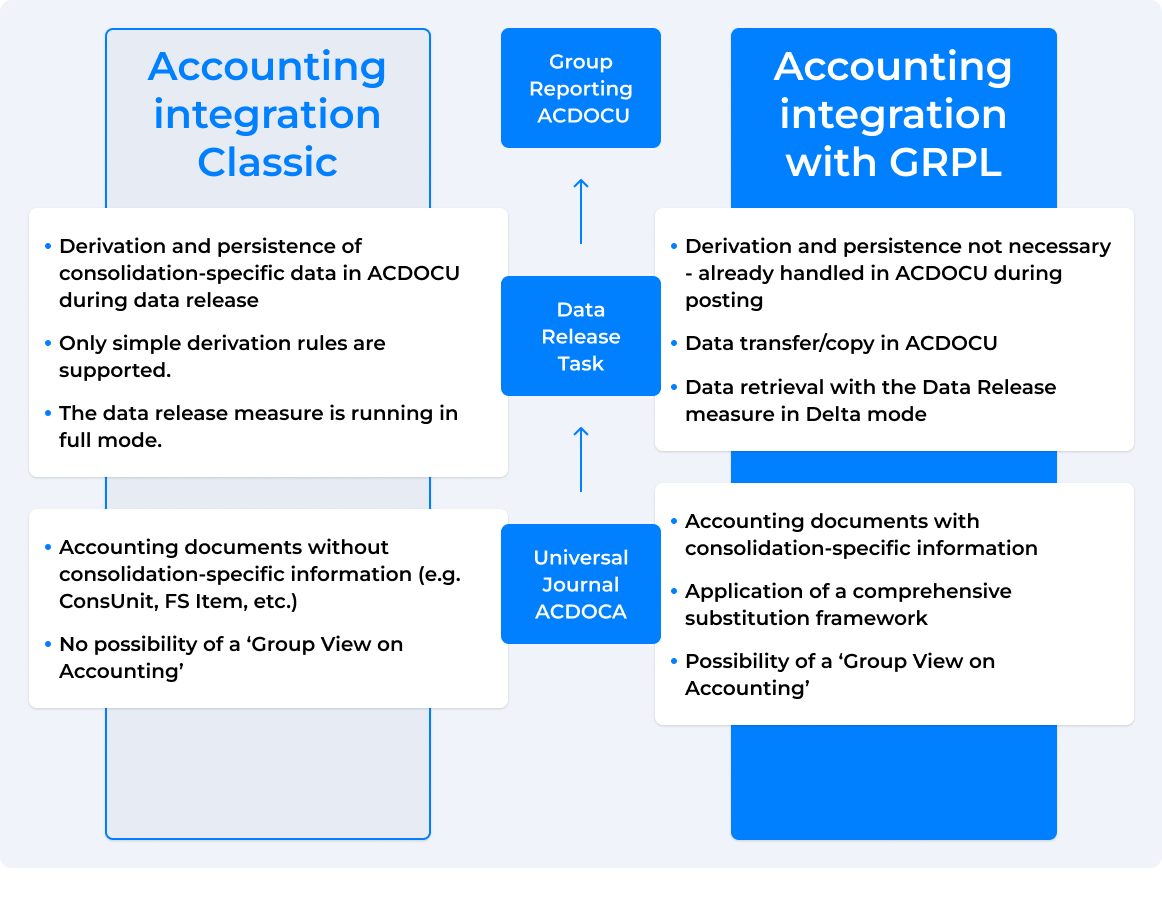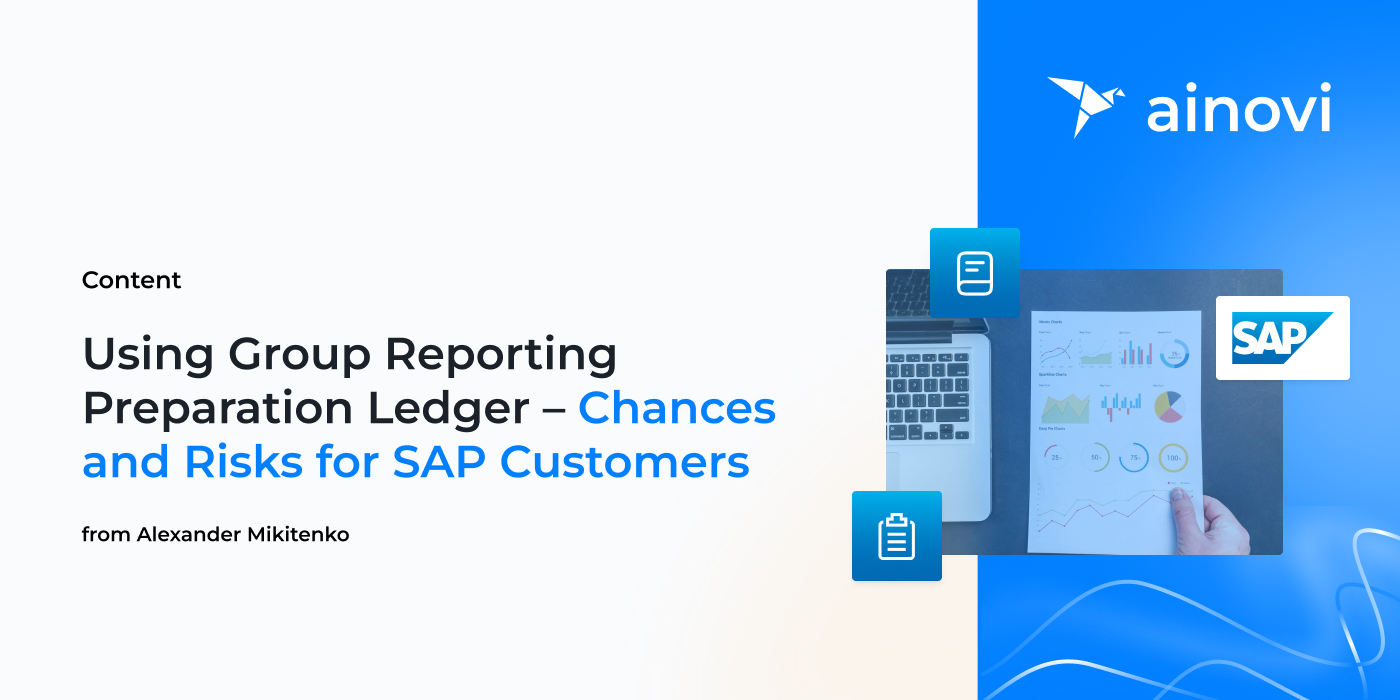Introduction
The introduction of SAP S/4HANA Group Reporting entails numerous strategic and technical decisions. One of these core questions concerns the so-called Group Reporting Preparation Ledger (GRPL) — a feature that can take the integration between operational accounting and group consolidation to a new level. But what exactly is behind GRPL? Which scenarios is it suitable for? And why do many companies initially consciously decide against activation?
In this article, we provide a practical overview of the function, benefits and technical framework conditions of GRPL — and also share valuable insights from real project processes that go beyond official SAP documentation.
What is GRPL? A bridge between individual financial statements and group report
The Group Reporting Preparation Ledger is a technical concept within SAP S/4HANA that enables a consolidation-relevant view of financial data directly in the Universal Journal (ACDOCA). It adds additional features to the journal, such as consolidation units, partner companies or types of consolidation, and thus allows the relevant information to be entered as soon as the operative booking is made.
In contrast to classic integration, in which the data from accounting is only transferred to the consolidation system via a release task, with GRPL, this intermediate step is completely omitted. The data can be consolidated right from the start and is immediately available for reporting in SAP Group Reporting.

Why GRPL remains (still) unused in many projects
Despite the many advantages that GRPL offers at first glance, we experience in many projects that companies have this function Deliberately do not activate at first. This is primarily due to the fact that GRPL activation involves setting a strategic course:
In Customizing SAP Group Reporting Will a so-called “From Year” Defined — the year from which GRPL data should be collected and used.
This attitude is irreversible. If GRPL is activated for one year, this can no longer be withdrawn retrospectively. To avoid risks during initial implementation, many companies therefore choose a placeholder value such as “9999” — and postpone activation to a later project as soon as processes and master data models are sufficiently stabilized.
Benefits of GRPL — seen from practice
For companies with a high level of integration into SAP Finance, GRPL provides tangible benefits:
- Simplifying the process landscape: By recording consolidation-relevant information directly in the accounting department at an early stage, there is no need for a separate approval process. This reduces the coordination effort between accounting and consolidation.
- Better data quality: Since relevant features such as partner companies or segment information are available immediately when booking, the incidence of errors is reduced and the quality of consolidation data increases significantly.
- Accelerated financial statements: Companies benefit from shorter lead times in monthly and quarterly financial statements, as consolidation data does not have to be separately enriched or transferred.
- More transparency and traceability: Since all relevant information is in the Universal Journal, discrepancies and booking details can be traced at any time — even for external auditors.
Especially in regulated industries — such as the energy sector — GRPL enables precise and compliant reporting that reliably takes into account requirements from HGB, IFRS or other local standards.
Technical requirements and implementation aspects
Activating GRPL requires a technical extension of the data model in the Universal Journal. Fields such as Consolidation Unit, Trading Partner, FS Item and others must be integrated into the journal. Reporting and data extraction must also be adapted to the new model.
It is particularly important that only operational data sources directly related to ACDOCA benefit from GRPL. For example, anyone who provides their reporting data exclusively via Group Reporting Data Collection (GRDC) — for example with external subsidiaries or hybrid setups — cannot use GRPL because this data is not posted in the journal.
Which companies is GRPL really suitable for?
Not every group benefits equally from GRPL. Our project experience shows that companies with a fully integrated SAP finance landscape and homogeneous processes in particular can take full advantage of the benefits.

Recommended project approach: GRPL as a second project stage
In practice, a two-stage implementation process has proven effective:
- Basic implementation without GRPL
The aim is a stable entry into group reporting — with a clean data connection, reporting structure and coordination between operational systems and consolidation. - Targeted GRPL activation in follow-up project
As soon as account plans have been harmonized, partner structures clarified and reporting requirements have been clarified, GRPL can be activated as an independent work step. This reduces risks and allows a structured introduction of the new logic.
Conclusion: GRPL is not a must — but an opportunity if properly prepared
The Group Reporting Preparation Ledger is a pioneering feature in SAP S/4HANA that brings consolidation closer to operational accounting — with significantly more transparency, speed, and efficiency.
But: It is not a mandatory part of the basic implementation of SAP Group Reporting. Companies should consciously decide whether and when to activate GRPL — depending on the data model, level of integration and level of strategic maturity.
Our tip:
Don't use GRPL “because you can,” but when it fits your group's architecture. Subsequent activation is technically possible — but early activation without proper preparation can lead to complications.








